It looks like you're using an Ad Blocker.
Please white-list or disable AboveTopSecret.com in your ad-blocking tool.
Thank you.
Some features of ATS will be disabled while you continue to use an ad-blocker.
share:
There are five plants that can be found virtually anywhere on our planet, except deserts and tropical areas. (sorry!) that everyone (or at the very
least the survivalists) should know how to use. If you are in the bush trying to survive the last thing you want to be doing is trying to identify a
plant "someone" told you was edible... but your not sure which part of it is, if it tasted good or if it even has nutritional value. (some edibles,
like acorns, will make you thirsty which is not good if your running low on water.) These plants will be of no surprise to you since they are as
common as the dirt they grow in. Hopefully you'll see them in a whole new light now!
I am going to focus mainly on how to use and cook them in a survival, backpacking and bug out situation. Mostly because these vitamins and nutrients can keep you alive and add a variety to wild meat and fish from hunting. I'm going to talk in simple terms for ease of use.
I'm going to do a plant at a time for now, just in case no one here is interested...would be a whole lot of typing for nothing otherwise.
Let's start with....
Burdock
You're not going to find Burdock in a forest with a tall canopy so you'll have to venture to a sunny spot with rich soil and some rocks. They really like rocks and small hills/slopes. If you're in the city find a vacant, run down lot. It'll be there. If it's rediculously rocky soil than pass by, you'll never get the root (trust me) and the root is very important.
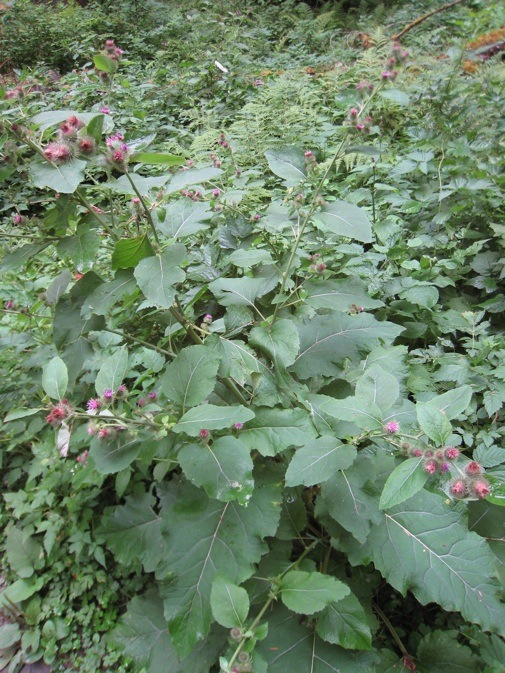

Root- It's a pain in the butt to dig up, it's really deep, probably 2-3 feet. Don't break it because it'll lose it's nutritional value and is a waste of a meal. It'll take awhile so get comfortable and go slow. If you have a hand trowel use it, but I dig them fine combining my knife, stick, sharp rock and gloved hands. Never use a shovel. Start digging 10" away from the base of the plant, roots tend to grow sideways and you'll want to figure out which way that is.
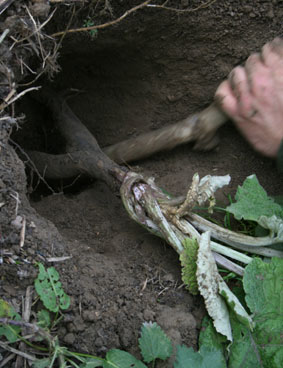
Always dig the root of the first year plants. When you hear people say that about Burdock it basically means "don't dig the root of the plant that has the tall, 3ft stalk with purple flowers or seeds with tapering leaf sizes" That root will be shrivled up and rotten. Dig the plant next to it (they always grow close to each other) with just the leaves- no stalk, no flowers, no seeds. It'll be more compact and look like rhubarb. This root is good. Dig this one and not the one above
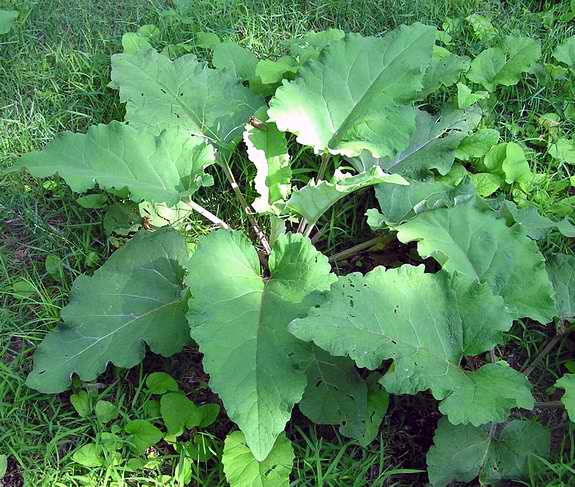
In the spring the small shoots with leaves are delicious. Collect the ones as small as your hand. You can eat the stems raw while traveling but I prefer to save the spring stems with leaves for the end of the day and boil (with or without) other greens you collected. They are a bit bitter but many love it this way.
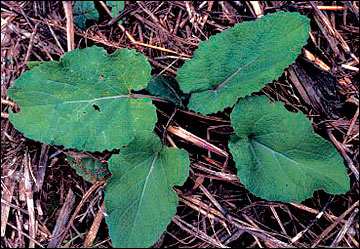
In the summer and fall those tender young leaves will be gone and the tall stalks with the flowers, seeds and tapering leaves(the ones you don't eat the roots of) will have grown to take their place. Try to catch them while they are emerging and leaves are still unfolding. That's when they taste wonderful.Strip the stalk of everything including it's skin. Eat raw, salted, but best if soaked and boiled. (photo below)

Obviously your going to want to wash all the leaves and stems and scrub the dirt of the roots. Don't remove the dirt from the root until right before you cook it, they shrivel fast otherwise.
This photo beow is a perfect example of your spring harvested Burdock root, very tender and those are the young spring leaves to eat as well. These are small roots, mostly because the soil they grew in was very, very wet but prime examples.
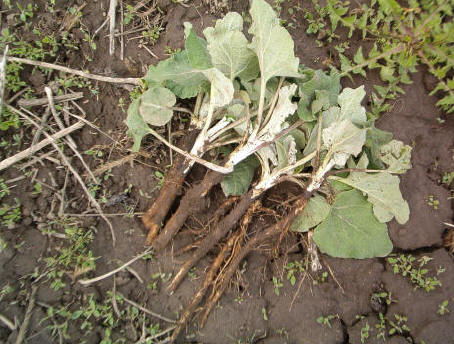
Right before you cook it chop it up.
The basic cooking method for all parts of the Burdock is the same when not added to a recipe. To cook the roots, the flower stems (stripped of their skin as I said above), or the washed young leaves, place whatever part you are using in a pot.
If you have salt add some, boil and then remove the greens or root from the pot. This is important in a survival situation (not so much at home)-- you want to SAVE that liquid, which by this point will be a deep, dark green and you want to drink it. It's good for you.
Then you'll need to cover with fresh water again and boil until the vegetable is tender. Leaves will be done in a few minutes; stems or roots will take longer, up to 15 or 20 minutes. Again, in a survival situation, drink the water.
In the winter you can sprout the Burdock seeds. Soak overnight, drain and sprout them. It has a bitter twang.
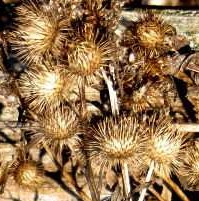
You can chop and dry the root and add to soups, stews, rice and beans.
The huge Burdock leaves are so, so helpful when you are cooking game and fish and potatoes over the campfire. They are natures aluminum foil.
And last but not least, good ole breakdown of nutritional value...had to look this one up for you.
Nutrient Amount
Protein 2.6 g
Water 94.6 g
Ash 1.2 g
Calories Amount
Total Calories 110
Calories From Carbohydrates 101
Calories from Fat 1.5
Calories from Protein 7.3
Carbohydrates Amount
Total Carbohydrates 26.4 g
Dietary Fiber 2.2 g
Sugars 4.4 g
Fats and Fatty Acids Amount
Total Fat 0.2 g
Vitamins Amount
Vitamin A 0.0 I.U.
Vitamin C 3.3mg
Vitamin E (alpha-Tocopherol) 0.6 mg
Vitamin K 2.5 mcg
Niacin 0.4 mg
Vitamin B6 0.3 mg
Folate 25.0 mcg
Pantothenic Acid 0.4 mg
Betaine 0.2 mg
Minerals 0
Calcium 61.2 mg
Iron 1.0 mg
Magnesium 48.8 mg
Phosphorus 116 mg
Potassium 450 mg
Zinc 0.5 mg
Copper 0.1 mg
Manganese 0.3 mg
Selenium 7.0 mcg
lifestyle.iloveindia.com...
www.buzzle.com...
Of course, Burdock is widely used as medicine as well... I mean, the kind of medicine you make yourself. That's for another time....yes, there is more from this wonderful plant. Now do you see why it's so important????
Every summer I teach a hands on wild edible class which is part of a larger survival course here in NE. People always tell me how overwhelmed they are by the vast amount of information they read on the web and in books. Not knowing where to start they will usually just give up all together. When I teach classes I stick with the 5 basic wild plants/weeds with optimal nutrition, medicinal value and avalibility. What's the point of learning about plants like Ginko if it only grows in China, you know? All of this information is based on experience and I use these plants on a daily to monthly basis for the past 16 years.
If anyone wants to know other ways I intergrate them in my daily cooking, how I make tinctures, infusions and medicine with them at the homestead I can share that too.
Hope this was useful to someone! I'll add more if there is interest.
Cheers!
I am going to focus mainly on how to use and cook them in a survival, backpacking and bug out situation. Mostly because these vitamins and nutrients can keep you alive and add a variety to wild meat and fish from hunting. I'm going to talk in simple terms for ease of use.
I'm going to do a plant at a time for now, just in case no one here is interested...would be a whole lot of typing for nothing otherwise.
Let's start with....
Burdock
You're not going to find Burdock in a forest with a tall canopy so you'll have to venture to a sunny spot with rich soil and some rocks. They really like rocks and small hills/slopes. If you're in the city find a vacant, run down lot. It'll be there. If it's rediculously rocky soil than pass by, you'll never get the root (trust me) and the root is very important.


Root- It's a pain in the butt to dig up, it's really deep, probably 2-3 feet. Don't break it because it'll lose it's nutritional value and is a waste of a meal. It'll take awhile so get comfortable and go slow. If you have a hand trowel use it, but I dig them fine combining my knife, stick, sharp rock and gloved hands. Never use a shovel. Start digging 10" away from the base of the plant, roots tend to grow sideways and you'll want to figure out which way that is.

Always dig the root of the first year plants. When you hear people say that about Burdock it basically means "don't dig the root of the plant that has the tall, 3ft stalk with purple flowers or seeds with tapering leaf sizes" That root will be shrivled up and rotten. Dig the plant next to it (they always grow close to each other) with just the leaves- no stalk, no flowers, no seeds. It'll be more compact and look like rhubarb. This root is good. Dig this one and not the one above

In the spring the small shoots with leaves are delicious. Collect the ones as small as your hand. You can eat the stems raw while traveling but I prefer to save the spring stems with leaves for the end of the day and boil (with or without) other greens you collected. They are a bit bitter but many love it this way.

In the summer and fall those tender young leaves will be gone and the tall stalks with the flowers, seeds and tapering leaves(the ones you don't eat the roots of) will have grown to take their place. Try to catch them while they are emerging and leaves are still unfolding. That's when they taste wonderful.Strip the stalk of everything including it's skin. Eat raw, salted, but best if soaked and boiled. (photo below)

Obviously your going to want to wash all the leaves and stems and scrub the dirt of the roots. Don't remove the dirt from the root until right before you cook it, they shrivel fast otherwise.
This photo beow is a perfect example of your spring harvested Burdock root, very tender and those are the young spring leaves to eat as well. These are small roots, mostly because the soil they grew in was very, very wet but prime examples.

Right before you cook it chop it up.
The basic cooking method for all parts of the Burdock is the same when not added to a recipe. To cook the roots, the flower stems (stripped of their skin as I said above), or the washed young leaves, place whatever part you are using in a pot.
If you have salt add some, boil and then remove the greens or root from the pot. This is important in a survival situation (not so much at home)-- you want to SAVE that liquid, which by this point will be a deep, dark green and you want to drink it. It's good for you.
Then you'll need to cover with fresh water again and boil until the vegetable is tender. Leaves will be done in a few minutes; stems or roots will take longer, up to 15 or 20 minutes. Again, in a survival situation, drink the water.
In the winter you can sprout the Burdock seeds. Soak overnight, drain and sprout them. It has a bitter twang.

You can chop and dry the root and add to soups, stews, rice and beans.
The huge Burdock leaves are so, so helpful when you are cooking game and fish and potatoes over the campfire. They are natures aluminum foil.
And last but not least, good ole breakdown of nutritional value...had to look this one up for you.
Nutrient Amount
Protein 2.6 g
Water 94.6 g
Ash 1.2 g
Calories Amount
Total Calories 110
Calories From Carbohydrates 101
Calories from Fat 1.5
Calories from Protein 7.3
Carbohydrates Amount
Total Carbohydrates 26.4 g
Dietary Fiber 2.2 g
Sugars 4.4 g
Fats and Fatty Acids Amount
Total Fat 0.2 g
Vitamins Amount
Vitamin A 0.0 I.U.
Vitamin C 3.3mg
Vitamin E (alpha-Tocopherol) 0.6 mg
Vitamin K 2.5 mcg
Niacin 0.4 mg
Vitamin B6 0.3 mg
Folate 25.0 mcg
Pantothenic Acid 0.4 mg
Betaine 0.2 mg
Minerals 0
Calcium 61.2 mg
Iron 1.0 mg
Magnesium 48.8 mg
Phosphorus 116 mg
Potassium 450 mg
Zinc 0.5 mg
Copper 0.1 mg
Manganese 0.3 mg
Selenium 7.0 mcg
lifestyle.iloveindia.com...
www.buzzle.com...
Of course, Burdock is widely used as medicine as well... I mean, the kind of medicine you make yourself. That's for another time....yes, there is more from this wonderful plant. Now do you see why it's so important????
Every summer I teach a hands on wild edible class which is part of a larger survival course here in NE. People always tell me how overwhelmed they are by the vast amount of information they read on the web and in books. Not knowing where to start they will usually just give up all together. When I teach classes I stick with the 5 basic wild plants/weeds with optimal nutrition, medicinal value and avalibility. What's the point of learning about plants like Ginko if it only grows in China, you know? All of this information is based on experience and I use these plants on a daily to monthly basis for the past 16 years.
If anyone wants to know other ways I intergrate them in my daily cooking, how I make tinctures, infusions and medicine with them at the homestead I can share that too.
Hope this was useful to someone! I'll add more if there is interest.
Cheers!
edit on 15-11-2011 by moondancer811 because: (no reason given)
edit on 15-11-2011 by moondancer811 because: (no reason
given)
edit on 16-11-2011 by moondancer811 because: typo
Awesome thread, love the info and pics.
Looking forward to more
Looking forward to more
This is fascinating. I hope you'll keep it up.
We have some open property in the middle of nowhere. We're discussing how we can slowly add self-sustaining edible plants that will like the climate, so that eventually it would be a place that would support a family if necessary. Or even if we just *wanted* to for our own reasons.
Next time we go I'm going to look for Burdock...
We have some open property in the middle of nowhere. We're discussing how we can slowly add self-sustaining edible plants that will like the climate, so that eventually it would be a place that would support a family if necessary. Or even if we just *wanted* to for our own reasons.
Next time we go I'm going to look for Burdock...
edit on 15-11-2011 by Schkeptick because: (no reason given)
Thanks guys! Glad you found it useful. Depending upon where you live you might still find Burdock. I've seen it growing in central park in NY and
here in the mountains. It looks rather pathetic right now but if the grounds not frozen you can harvest and dry the root or make a tincture...I
didn't get into tinctures yet, BUT...look for it! I'll take a picture of it "dead" tomorrow.
reply to post by moondancer811
Great thread, S & F! I will never forget the time that I was 9 years old, living in England, & fell into a huge patch of nettles- hands first. WOW, the PAIN! Fortunately my aunt pulled up a bunch of burdock leaves & covered my hands with them. The leaves cooled the pain from the nettle needles & healed the swollen welts within a few hours. A lifesaver!
Great thread, S & F! I will never forget the time that I was 9 years old, living in England, & fell into a huge patch of nettles- hands first. WOW, the PAIN! Fortunately my aunt pulled up a bunch of burdock leaves & covered my hands with them. The leaves cooled the pain from the nettle needles & healed the swollen welts within a few hours. A lifesaver!
reply to post by RomaMayLi
I'm laughing here at your story...guess which is one of the plants that is in the top 5??? You're tormentor. One of the most nutritious, tasty and useful "weeds" in the world- Stinging nettles! You don't believe me now, but...wait and see.
I'm laughing here at your story...guess which is one of the plants that is in the top 5??? You're tormentor. One of the most nutritious, tasty and useful "weeds" in the world- Stinging nettles! You don't believe me now, but...wait and see.
Nice job! It's vital to have good pictures so people can see what the plant looks like and how to use it. One of the best threads done on a single
plant, my compliments.
What are the other 4 plants you teach along with burdock, I have my own list that works in Virginia but I take it you are in New England where things are a little different.
In Japan burdock is called Gobo and it's eaten with soy sauce. Yum! It;s my favorite wild root and second favorite green after lambs quarters.
I hope you will do more of these threads to help educate everyone on wild edible plants. Getting back to having a meaningful relationship with nature is something foraging can help establish. Saves money and is good for your health in many ways!
Thanks!
What are the other 4 plants you teach along with burdock, I have my own list that works in Virginia but I take it you are in New England where things are a little different.
In Japan burdock is called Gobo and it's eaten with soy sauce. Yum! It;s my favorite wild root and second favorite green after lambs quarters.
I hope you will do more of these threads to help educate everyone on wild edible plants. Getting back to having a meaningful relationship with nature is something foraging can help establish. Saves money and is good for your health in many ways!
Thanks!
edit on 16-11-2011 by Asktheanimals because: corrections
reply to post by moondancer811
I was just talking to my uncle about this very plant, and its usefulness in a survival situation.
I had to take the time to give you thanks for such a useful thread.
The one thing that separates us from beasts, is our ability to communicate.
Please continue to spread your storehouse of understanding within the natural world.
I, and many others, will continue to appreciate, and utilize your knowledge.
I was just talking to my uncle about this very plant, and its usefulness in a survival situation.
I had to take the time to give you thanks for such a useful thread.
The one thing that separates us from beasts, is our ability to communicate.
Please continue to spread your storehouse of understanding within the natural world.
I, and many others, will continue to appreciate, and utilize your knowledge.
I know little to nothing about plants, but your pictures are exactly what's in my backyard. I will have to check further into these before I start
eating off the ground in my yard, the neighbors already think I'm a little weird.
reply to post by Asktheanimals
Great to see a Mod that has a link to wild edibles. I'm new here so wasn't really sure if there would be any interest. Thank you for the compliments! I am more than happy to share what I do know and learn what I don't.
I am soooo not going to tell you my top 5, you'll just have to wait and see. I am curious how similar they are to yours, we do basically have the same common weeds here as you do in Virginia. You'll have to let me know.
Cheers!
Great to see a Mod that has a link to wild edibles. I'm new here so wasn't really sure if there would be any interest. Thank you for the compliments! I am more than happy to share what I do know and learn what I don't.
I am soooo not going to tell you my top 5, you'll just have to wait and see. I am curious how similar they are to yours, we do basically have the same common weeds here as you do in Virginia. You'll have to let me know.
Cheers!
reply to post by JibbyJedi
Honestly, Burdock grows EVERYWHERE! Take a picture of the one in your backyard and post it. Once you identify it you'll see it growing all over the place. It even grows in cracks of sidewalks...don't overlook it, it's such good food and medicine.
Honestly, Burdock grows EVERYWHERE! Take a picture of the one in your backyard and post it. Once you identify it you'll see it growing all over the place. It even grows in cracks of sidewalks...don't overlook it, it's such good food and medicine.
reply to post by xsheep
I was trying not to get technical because it's confusing but Butter Dock is part of the rumex family "rumex obtusifolius" and Burdock is "artium lappa." I don't want anyone to confuse the two plants. They honestly look nothing alike in person nor in the same family but the common name sounds similar.
I was trying not to get technical because it's confusing but Butter Dock is part of the rumex family "rumex obtusifolius" and Burdock is "artium lappa." I don't want anyone to confuse the two plants. They honestly look nothing alike in person nor in the same family but the common name sounds similar.
edit on 16-11-2011 by moondancer811 because: correcting latin name
I think a hard challenge for the average person is identifying these, and you did a wonderful job making that simple for all of us.
Thanks for the thoughtful post.
Thanks for the thoughtful post.
reply to post by xsheep
Thanks so much for clearing that up! Just in case I or anyone I know has need of it again. I'm also aware that stinging nettles are supposed to be good for what ails you as a tea, etc. but I think I'll pass on any further experiences with it for now!
Thanks so much for clearing that up! Just in case I or anyone I know has need of it again. I'm also aware that stinging nettles are supposed to be good for what ails you as a tea, etc. but I think I'll pass on any further experiences with it for now!
reply to post by moondancer811
Goddess, and I though that was a weed! Have some great ones in my yard every year and I cut them down. Every year I am more and more happy that I chose to leave this little field in it's natural state. So far, I am finding out that most of my yard is edible, unlike neighbors with "pretty grass"!
Great article! Well done and good photos. Images are SO important for such things. I have an old book with lots of info but line drawings. I'm not gonna trust a line drawing with my life. Good photos, from multiple sources, I will trust.
Goddess, and I though that was a weed! Have some great ones in my yard every year and I cut them down. Every year I am more and more happy that I chose to leave this little field in it's natural state. So far, I am finding out that most of my yard is edible, unlike neighbors with "pretty grass"!
Great article! Well done and good photos. Images are SO important for such things. I have an old book with lots of info but line drawings. I'm not gonna trust a line drawing with my life. Good photos, from multiple sources, I will trust.
Excellent post! This stuff grows literally everywhere in my area (I live in Idaho); alleys, vacant lots, hillsides, etc. and is generally treated as a
weed.
If I am recognizing the plant correctly, its most notable features hitherto reading this post were its seed heads which are the bane of socks and sweaters if encountered while hiking. If I had a dollar for every time I peeled handfuls of these off my clothes... I had no idea that it was such a beneficial plant. I'll not be so cavalier about it the next time I come across some.
Thanks for the information!!
I have subscribed to the thread and I am certainly looking forward to more.
If I am recognizing the plant correctly, its most notable features hitherto reading this post were its seed heads which are the bane of socks and sweaters if encountered while hiking. If I had a dollar for every time I peeled handfuls of these off my clothes... I had no idea that it was such a beneficial plant. I'll not be so cavalier about it the next time I come across some.
Thanks for the information!!
I have subscribed to the thread and I am certainly looking forward to more.
reply to post by clowdstalker
Yes! That is the plant.
I am getting ready to post more pics of digging and bringing the roots home to make a medicinal tincture now.
Yes! That is the plant.
I am getting ready to post more pics of digging and bringing the roots home to make a medicinal tincture now.
You mention Burdock leaves are nature's aluminum foil - it's also nature's Charmin!
Great post!
Great post!
new topics
-
USSS Agent Fired for Having Sex In Michelle Obama's Bathroom
US Political Madness: 1 hours ago -
Watching TV
Jokes, Puns, & Pranks: 4 hours ago
top topics
-
RFK is Trumps health pick
2024 Elections: 12 hours ago, 18 flags -
USSS Agent Fired for Having Sex In Michelle Obama's Bathroom
US Political Madness: 1 hours ago, 6 flags -
Watching TV
Jokes, Puns, & Pranks: 4 hours ago, 5 flags
active topics
-
FLORIDA Sues Biden-Harris FEMA for Denying Disaster Assistance to Homeowners with TRUMP Signs.
US Political Madness • 46 • : network dude -
USSS Agent Fired for Having Sex In Michelle Obama's Bathroom
US Political Madness • 12 • : WeMustCare -
WATCH LIVE: US Congress hearing on UFOs, unidentified anomalous phenomena
Aliens and UFOs • 68 • : WeMustCare -
The Reactionary Conspiracy 13. The plot’s theology.
General Conspiracies • 296 • : MarxistDebunker2 -
Thune selected as Senate Republican Leader
US Political Madness • 72 • : CriticalStinker -
The art of being offended
Social Issues and Civil Unrest • 38 • : bastion -
Post A Funny (T&C Friendly) Pic Part IV: The LOL awakens!
General Chit Chat • 7774 • : underpass61 -
The Acronym Game .. Pt.4
General Chit Chat • 955 • : tinkerbell99 -
RFK is Trumps health pick
2024 Elections • 8 • : marg6043 -
Qatar kicks out HAMAS
Middle East Issues • 20 • : bastion
